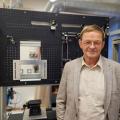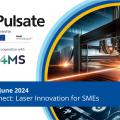Paieška
2024. 04. 08
-
Physicist Dr. G. Račiukaitis on the capabilities of ELI lasers: their accelerators are as powerful as CERN's, but take up much less space
On 5 April, an international workshop on "Laser particle accelerators, their applications and possibilities of experiments in the ELI infrastructure" took place at the Center for Physical Sciences and Technology (FTMC). Researchers and laser experts from the Czech Republic, Italy, Israel, Lithuania, Romania and Hungary shared and discussed their insights.
The Extreme Light Infrastructure (ELI) is an international laboratory system that uses high-power, ultra-short pulsed lasers. Although there are currently no such facilities in Lithuania (they are located in the Czech Republic, Hungary and Romania), this country is one of the founding members of the ELI and is making a significant contribution to this important initiative with its own lasers and expertise.
During the seminar, foreign and Lithuanian scientists presented the current opportunities for researchers to visit ELI facilities to test the next generation of lasers for experiments.
Dr. Gediminas Račiukaitis, one of the organisers, President of the Lithuanian laser association, Head of the FTMC Department of Laser Technologies, talks about the idea of the event.

(A snapshot of the seminar. Presentation by Italian physicist Leonida A. Gizzi. Photo: FTMC)
One of the objectives of last year's workshop was to get Lithuanians more involved in ELI activities and to use the laser infrastructure. What progress has been made during the year?
Twice a year, there are user calls for experiments. One of these calls ends in the second half of April. That's what we have linked this spring event to, and the other call will be in the fall.
Lithuania submitted four applications during the year, all of which were successful. Some experiments have already taken place and some are in the pipeline. As you would expect, the need is primarily felt by laserists and laser-related people, but we are now seeing interest from the medical profession and the National Cancer Institute in Lithuania. I am pleased that our nuclear physics experts have also come here. We hope that more scientists from different fields will get involved - maybe they will also find topics where they can use the ELI infrastructure.
We have always dreamed of having high-power lasers, like a shoemaker dreams about the best shoes. But we realise that it would be too expensive to maintain ELI's infrastructure in Lithuania: our people are busy, they make all sorts of lasers themselves, and it would be too expensive to want specialists to maintain the new lasers too. So it is better for us to go abroad, do experiments - and work together to create something.
And this seminar was an opportunity to invite people, some of whom I am seeing for the first time in my life, but who I know are top inthe world in this field. They see what we have in Lithuania, and we make closer contacts. And then we look at how we can get into those ELI systems, how we can get our laser companies into the roadmaps, so that the names of those companies are there. And then things start to work differently.
How do Lithuanians already contribute to ELI?
One of ELI's facilities in Szeged, Hungary, has installed our lasers and they are already operating stably. Another thing is that we are founding members. This is important. ELI is the only scientific infrastructure of which Lithuania is a founding member! It's not the same as in other organisations like CERN or other places where Lithuanians try to become members, we pay a fee, we wait for them to invite us...
And here we are the founding members. We go to the general assemblies on equal terms and we make the arrangements. This shows how much we have achieved in the field of lasers.

(ELI-ALPS Laser Institute in Hungary. Photo: eli-alps.hu)
One of the main topics of this year's workshop is laser particle accelerators. In a nutshell, what is it?
This is a technology where a laser ionises materials, separating the ions and electrons in them and creating a very strong electric field at a very small - micrometric - distance. This field strongly accelerates some of the electrons trapped in the resulting plasma bubble.
We only need a few centimetres to achieve the kind of energy that CERN needs metres or even kilometres to produce. Of course, there are all sorts of subtleties that limit the technology - that's what we're talking about at the event. But sometimes you don't need something very big. We could do with a small thing to help us realise our dream of treating cancer more effectively.
As one of the participants [a renowned French physicist, scientific director of the ELI NP research centre in Romania] Victor Malka - he is trying to set up systems to have a laser particle accelerator in every hospital to treat cancer. Similar equipment to the National Cancer Institute in Lithuania is suitable for treating superficial tumors. It is not for the inside. That needs high energy, which requires a stadium-sized accelerator. But with the ELI laser, half a room would be enough.

(A snapshot of the seminar. Presentation by French physicist Victor Malka. Photo: FTMC)
Are the most ambitious goals of the ELI specifically related to medicine?
They are the most interesting for us. Because this is the subject that is closest to each of us. We want to do something better in terms of treatment and maybe even make such equipment cheaper than the systems that exist now.
Written by Simonas Bendžius
For full illustrated information on the ELI and upcoming user calls, please click on this link.
Susiję:

2024. 12. 06
-
Next-generation Lasers from Czechia and Lithuania Leading the Way for Europe’s Industrial Competitiveness
Led by Czechia’s HiLASE Centre and Lithuania’s FTMC, the LASER-PRO project stands out as a shining example of cross-border collaboration.

2024. 08. 28
-
Dr. O. Pronin's seminar "Toward a compact XUV frequency comb source"
He is one of the students of Prof. Ferenc Krausz, Nobel Prize winner for attosecond lasers.

2024. 07. 01
-
UPLAMP 2024 summer school
All laser microfabrication professionals and students are welcome! The summer school will take place on July 1-6.

